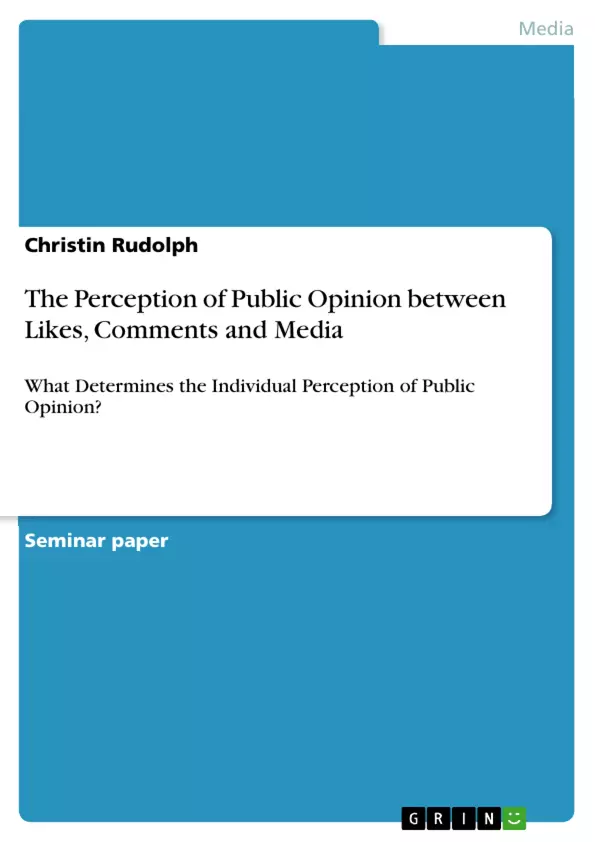Especially for democratic political systems, public opinion plays a major role in the political Research on public opinion often focuses on aggregated effects. But how do individuals assess what millions of people they have never met think about single issues? In recent years, SNS have become increasingly important for politics. They pose a new means of campaign activities and are targets of new laws, e.g. the Netzwerkdurchsetzungsgesetz in Germany, but have also been used for deception (cf. Hameleers and Schmuck 2017, Esser, Stepinska and Hopmann 2016). These developments and the lack of-up-to-date evidence in the literature led me to the following research question: What determines the individual perception of public opinion?
The remainder of the paper is structured as follows. After some remarks concerning the definition of the term public opinion, I will discuss single influential works for the field in general and, briefly, the literature of the past two decades examining the specific micro-level relationship. As the paper aims to examine current implications, a focus lies on the effects of aggregated user opinion representations and comments on SNS embedded in the frameworks of the spiral of silence (Noelle-Neumann 1974, 1977, 1993), social projection (Fields and Schuman 1976) and the persuasive press inference (Gunther 1998).
Inhaltsverzeichnis (Table of Contents)
- The Individual Perception Matters...
- What Determines the Individual Perception of Public Opinion? - An Overview.....
- The Individual's Own Opinion...
- Social Projection......
- Possible Intervening Variables...
- Implications in Regard to Filter Bubbles...
- The Persuasive Press Inference and its Implications...
- The Spiral of Silence Applied: The Influence of Comments and Likes……..\n
- The Spiral of Silence in the Age of the Web 2.0.......
- Possible Opinion Cues From Likes and Approval Ratings..\n
- Reading Comments Online - Substantive and Substantial Influence or a Waste\nof Time?..\n
- The Individual's Own Opinion...
- Hypotheses....
- Bibliography....
Zielsetzung und Themenschwerpunkte (Objectives and Key Themes)
This paper explores the factors that influence an individual's perception of public opinion, particularly in the context of social media. The author examines the influence of an individual's own opinion, social projection, and the impact of aggregated user opinions and comments on social networking sites (SNS). The paper aims to understand how individuals form their perception of public opinion in the digital age and the implications of these perceptions on political discourse and participation.
- The individual's perception of public opinion
- The influence of social media on public opinion perception
- The impact of aggregated user opinions and comments on SNS
- The role of social projection in public opinion perception
- The implications of public opinion perception for democratic processes
Zusammenfassung der Kapitel (Chapter Summaries)
- The Individual Perception Matters...: This chapter introduces the concept of public opinion and its importance for democratic political systems. It discusses the influence of public opinion on political actors and the role of institutions in shaping it. It also highlights the need to understand how individuals perceive public opinion and the factors that influence this perception.
- What Determines the Individual Perception of Public Opinion? - An Overview...: This chapter provides an overview of the key factors that influence an individual's perception of public opinion. It introduces three main variables: the individual's own opinion, the content of perceived media coverage, and the group attachment of the subject.
- The Individual's Own Opinion...: This section discusses the concept of social projection, the tendency for individuals to perceive their own opinion as being shared by others. It explores various theoretical explanations for this phenomenon, including the accessibility bias, the need for social support, and the tendency to see one's own opinion as sensible and therefore shared by others.
- The Persuasive Press Inference and its Implications...: This section explores the role of the media in shaping an individual's perception of public opinion, focusing on the concept of the persuasive press inference, which suggests that individuals rely on media coverage to form their understanding of public opinion. The section examines the implications of this inference for democratic processes and the potential for manipulation by media outlets.
- The Spiral of Silence Applied: The Influence of Comments and Likes……..\n: This section discusses the influence of online comments and likes on an individual's perception of public opinion. It examines how these elements can influence the perception of public opinion and how they contribute to the "spiral of silence" phenomenon. The section also discusses the importance of understanding how these online interactions shape individual perceptions and contribute to the overall climate of opinion.
Schlüsselwörter (Keywords)
The main keywords and focus topics of this text include public opinion, individual perception, social media, social projection, persuasive press inference, spiral of silence, likes, comments, social networking sites, and online interaction. These terms represent the core concepts and research focuses of the paper, exploring the complex relationship between individuals, public opinion, and the digital environment.
- Citation du texte
- Christin Rudolph (Auteur), 2018, The Perception of Public Opinion between Likes, Comments and Media, Munich, GRIN Verlag, https://www.grin.com/document/465471



